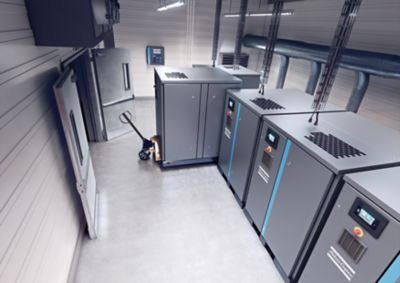Industrial gas generation – Why the time is right to switch to on-site sourcing
Arron Farghaly MEng – Lead Application and Business Development Engineer Atlas Copco Compressors
For much of this and last century and throughout UK industry, a dependable supply of industrial gases such as nitrogen and oxygen has been as crucial to critical processes as the supply of electricity, water and gas utilities. Now, major advances in on-site gas generation technology have transformed the way users are able to source industrial gases. Many companies and industries have converted to on-site, self-sufficient generation of industrial gases. As a result, these companies have made substantial gains in productivity, energy efficiency and cost savings.
Dramatic changes in gas generation
Eliminating product losses
Power consumption and product loss are significant factors in the supply of liquid nitrogen. Firstly, it requires a great deal of electrical energy to reach the liquefaction point down to -196o C. Also, the delivery procedure to point of use requires the nitrogen to be in liquid form for transportation before being converted back to gas once it’s on site. Inevitably, there is product loss during the transfer and ultimate storage process. Delivered nitrogen, stored on site in a cooled tank prior to use loses some of its volume to venting. This amounts on average to 0.3-3% of its volume each day, dependent on ambient temperatures and consumption demand. Also, if bottled gas is the supply method used, a certain volume of gas, depending on bottle size and final pressure, will be returned to the supplier following every single use. This loss can constitute up to 10% of the delivered gas.
Specific requirements
Industrial applications
It is much the same story for other industrial applications. For instance, in fibre laser cutting processes, where nitrogen is often critically employed as an assist gas which is usually delivered from high pressure cylinder packs. These packs are ten times more expensive in terms of energy requirement than on-site production of the gas. Similarly, the electronics industries employ nitrogen in many roles, primarily as a cooling and blanketing medium in semiconductor, electronics and instruments manufacture. Other major users are on oil, gas, chemical and petrochemical processing sites utilising nitrogen for blanketing to prevent explosive atmospheres in tanks of fuel or chemicals. None of these applications require high purity nitrogen to prevent explosions or fires. Dependent on the minimum oxygen concentration of the flammable substance, a purity level between 95-99% per cent is quite sufficient. What is more, the remote location of some operating sites makes a reliable, continuous, independent supply a necessity in order to maintain process operations.
The role of oxygen in biogas, water treatment and aquaculture
Relative costs
The cost of delivered liquid nitrogen can range from 10p per m3 to 30p per m3. For bottles, it’s from 60p to £3 per m3. In stark contrast, the product cost of generating nitrogen on site can be as little as 2.5p per m3, averaging at 4.5p, and costing no more than 9p per m3 depending on purity, flow and pressure requirements. Users of on-site systems not only report increased levels of productivity, but also the outstanding cost benefit derived from the installation regardless of location. At start up, many of these growth industries may need capital equipment investment for industrial gas supplies. Whether this funding is designated for liquid storage facilities or for on-site generation equipment, when relative costs are reviewed, the strongest case by far tends to be for on-site generation solutions. For industrial gas users who find themselves without the capex to make the initial investment for their own on-site production, finance deals are becoming more readily available. By switching to a financed on-site solution, many companies will start to save from day one whilst being more productive, profitable and self-sufficient.
Cycle time modulation
Generator Air Factor
A nitrogen generator’s air factor defines the compressed air volume required to obtain a specific nitrogen flow. As a leader in the design, development and manufacture of nitrogen generators, Atlas Copco’s latest NGP+ units’ key feature is their industry-low air factor which translates into low total cost of ownership, offering up to 50 per cent reduction in running costs compared to other nitrogen generators. Atlas Copco continually gathers and analyses data from applications around the world to progress industrial gas processes. As a result, it is positioned to help UK manufacturers improve their productivity, processes, energy efficiency, and their bottom line.
On-site nitrogen generation proves outstanding success for Salford craft brewery
A newly installed and highly innovative compressed air and on-site nitrogen generation system from Atlas Copco is providing a key driver in the Outstanding Brewing Company’s on-going commitment to enhance its product quality, productivity and growth. In keeping with the brewery industry at large, the Salford-based company has to rely on a continuous supply of compressed air and nitrogen as a critical element at every stage of the production process: right from purging kegs and tanks, oxygenating beer to promote fermentation, right through to filling, bottling, labelling and packaging the final product. An energy-efficient Atlas Copco rotary screw compressor feeds a plug-and-play NGP+ generator that employs Pressure Swing Absorption (PSA) technology and is fully automated and monitored, with an oxygen sensor as standard. A special off-spec check feature means that nitrogen with a purity that is under the specified threshold cannot reach the sensitive process application.

